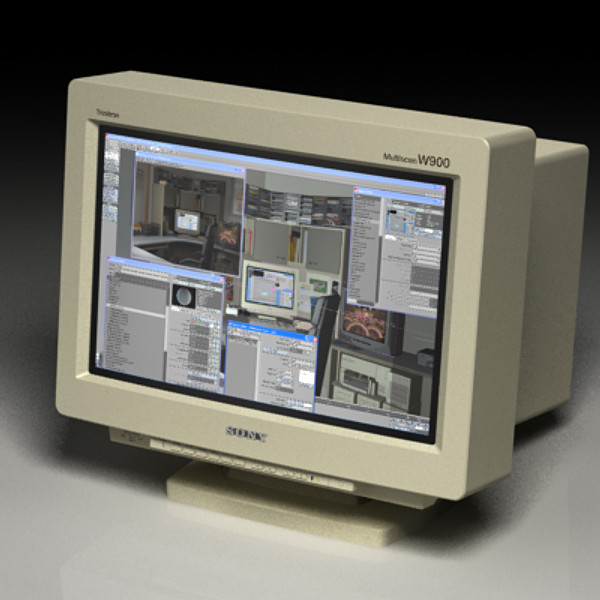The publisher of Display Daily, Meko Ltd, has an unofficial saying “Don’t forget the people” – designed to remind us that, as I like to say “A display without a person has no purpose”. I often attend display events where nobody talks about the users or the human factors of display use. The phrase also reminds us that products are bought by people, the irrational, emotional creatures that we all are, not by logical economic agents.

Over the last few weeks, I’ve been trying a 32″ UltraHD monitor from Eizo, the EV3237. It’s a lovely monitor and even though my PC is a little old and only supports 30Hz refresh* at UltraHD resolution, as I do little video and no game play, it’s not a problem. I started with high resolution monitors many, many years ago. When I was working in the industry, some 30 years ago, I used a 21″ monochrome CRT display because it gave me 1600 x 1200, when colour systems were 1280 x 1024.
I then went to 17″ colour, the wonderful Eizo T560i – probably the pinnacle of commercial colour monitors, with a fantastic chassis and a top of the range Sony Trinitron tube – and a price to match – around $2,200 if I remember correctly!).
 Sony W900 Monitor was my first 16:10 monitorLater I moved to a 21″ Nokia (with a Hitachi Dynamic Focus CRT) and then on to my last CRT – a 24″ Sony 16:10 W900 Trinitron monitor that supported 1920 x 1200 (and 54Kg in weight, so I had to reinforce my desk!). All the time, once I went to colour, the monitors were getting bigger and bigger and I resisted going to LCD until I got a Philips 24″ LCD with 1920 x 1200 resolution. I stuck with that monitor for around 8 years from 2003 until 27″ 2560 x 1440 monitors came along. I bought a Dell of that size and resolution.
Sony W900 Monitor was my first 16:10 monitorLater I moved to a 21″ Nokia (with a Hitachi Dynamic Focus CRT) and then on to my last CRT – a 24″ Sony 16:10 W900 Trinitron monitor that supported 1920 x 1200 (and 54Kg in weight, so I had to reinforce my desk!). All the time, once I went to colour, the monitors were getting bigger and bigger and I resisted going to LCD until I got a Philips 24″ LCD with 1920 x 1200 resolution. I stuck with that monitor for around 8 years from 2003 until 27″ 2560 x 1440 monitors came along. I bought a Dell of that size and resolution.
Now I have the 32″ and it seems that it might, just, be a bit too big. Or, more precisely, it may be too high.
Over the last few weeks, I have spent almost all of my waking hours sorting out the Display Daily website and its transition to a more modern platform. The resolution of the monitor has been fantastic. Although some fonts are a bit small, the quality is great. However, at the end of long days, I found the back of my neck and upper spine starting to ache. That’s because I have had my head tipped back to look at the top of the screen and that really causes trouble in the spine. So, now, I have adjusted the monitor so that the base of the display is basically just the depth of the stand above my desk, in order to bring the menus at the top of the Windows screen closer to my eyeline. I’ll report back on this.
I was discussing this with my wife, who lectures at a local college in the UK. She mentioned that the health and safety advice at her college is to “make sure your monitor is high enough”. That advice seems to be very, very out of date. The current research, as I understand it (and I’m a member of the HFES, although not a practitioner), is that looking slightly down eases the convergence effort needed to focus on close images. So, the eye specialists tend to want to move displays down, below the eyeline, or where the eye is level with the top of the display. On the other hand, tipping the head forward too far puts too much stress at the top of the spine. (Which is why it’s against employment health and safety law to make people in the EU work all day at notebook displays.)
So the compromise between the visual ergonomists and those that look after muscular-skeletal issues is somewhere between the two extremes.
My experience suggests that I should look at a 34″ 21:9 – which would mean a screen height of 13.39″ – more or less identical to the 27″ that I used and loved for years, but with more pixels. However, it would mean dropping back to 115 ppi rather than the 140 of the 32″ that I’m using and that would be a shame. I’d like something like 4200 x 1800 resolution, please!
Bob
* Note that the monitor worked very well at 60Hz when I connected it as dual 1920 x 2160 displays using the DisplayPort connection on my docking station as well as the output on my notebook.
| Model | Diagonal | Aspect Ratio |
Height |
|---|---|---|---|
| 6500 | 21″ | 4:3 | 12.6″ |
| T560i | 17″ | 4:3 | 10.2″ |
| Nokia | 21″ | 4:3 | 12″ |
| Sony W900 | 24″ | 16:10 | 12.19″ |
| Philips | 24″ | 16:10 | 12.72″ |
| Dell | 27″ | 16:9 | 13.24″ |
| Eizo EV3237 | 31.5″ | 16:9 | 15.44″ |

